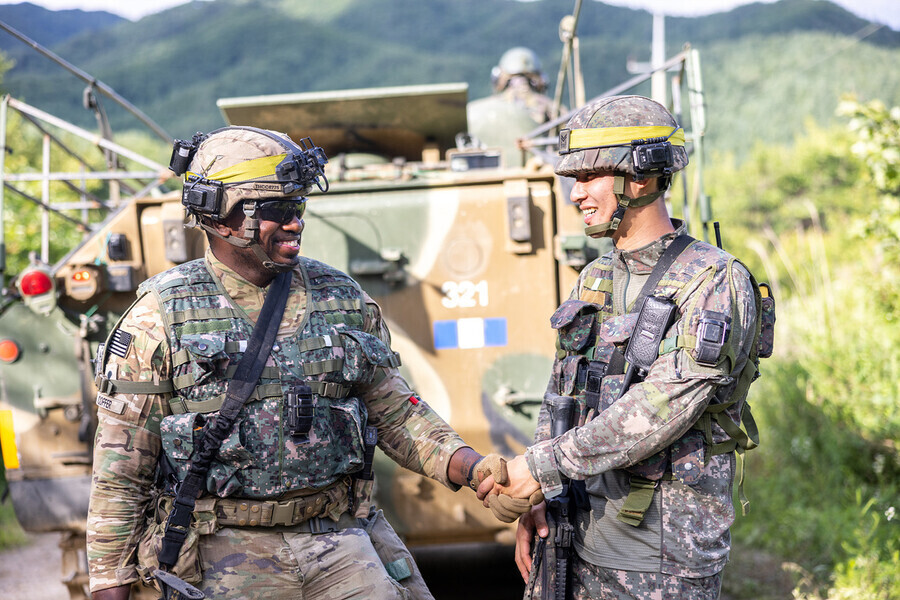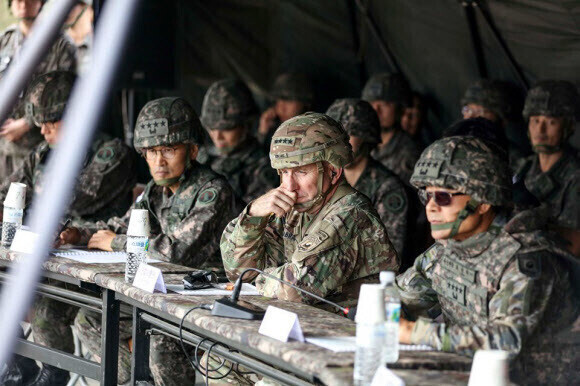hankyoreh
Links to other country sites 다른 나라 사이트 링크
Are this month’s S. Korea-US joint drills really the biggest in years? Not quite

South Korea and the US have kicked off Ulchi Freedom Shield, a regular joint military exercise scheduled to run from Aug. 22 to Sept. 1 this year.
In press materials it released Tuesday, the South Korean military explained that it would be “normalizing the South Korea-US joint exercises and field exercises that have been downscaled and modified for some time, in order to rebuild the South Korea-US alliance and establish a robust allied defense posture.”
South Korean military authorities explained that the exercise would “not be limited to computer simulation-based command post exercises” and would “also include live joint field exercises at a tactical level by echelon and function.”
They added that there would be “a total of 13 joint field drills taking place during the exercise, including joint scientific combat training (brigade-level) and joint WMD removal training (battalion-level).”
Based on that information, the media have reported that large-scale field exercises are “making a comeback” after four years.
But a closer look at the exercise suggests the claims of a comeback are overstated. The 13 drills mentioned are ones that were previously conducted, with no additional ones included. It’s inaccurate to speak of a “comeback” when the two sides are simply doing what were previously 13 separate drills all at once during their joint exercise.
The 13 drills may be happening all at once rather than being scattered throughout the year, but it’s still 13 drills per year. It’s a bit of deceptive packaging.
None of the 13 drills is large enough in scale to be referred to as a “large-scale field maneuver” either.
Twelve of them are taking place at the battalion level or a similarly small scale. There is only one brigade or higher-level drill involving thousands of participants, but with most of the participants coming from the South Korean military and the US sending no additional troops from its own territory, it will reportedly involve the participation of hundreds of US Forces Korea troops at the company level.

On July 15–18, around 4,300 members of two South Korean military brigades formed battle groups for bilateral drills in mutual combat at the Korea Combat Training Center in Inje, Gangwon Province. At the time, around 300 troops took part from two USFK infantry companies.
Theater-level joint military exercises — where the entire Korean Peninsula is treated as a battlefield — take place twice a year: once in March and once in August.
Since long before the administration of previous President Moon Jae-in, the March exercises have included a combination of field training exercises with large-scale use of troops and equipment, and command post exercises (CPX) using computerized war games. The August exercises have tended to be focused on CPX, without a field exercise component.
In an explanation of the joint exercise, the Joint Chiefs of Staff website states that it is “carried out by commanders and staff officers with an emphasis on mastering operational procedures under a battlefield situation created via computer simulation.”
The latest joint exercise will also reportedly center around CPX, with little difference from past years in terms of the scenarios (an initial “defense” component and second “counterattack” component) and scope.
This suggests that military authorities are assigning too much significance to their approach of holding the same drills as in the past all at once when they refer to it as “rebuilding the South Korea-US alliance” or “normalizing joint military exercises and field exercises.”
During the Moon administration, military officials explained that the command post exercises alone were significant as a review of the joint South Korea-US posture, and that an equivalent training effect could be obtained by integrating command, control, communication, and intelligence equipment without the use of actual troops.
Seeing the way that military authorities and the Ministry of National Defense have swiftly changed their tack since the arrival of the Yoon Suk-yeol administration in May brings to mind a line in Kim Su-young’s poem “Grass”: “It lies flat more quickly than the wind.”
By Kwon Hyuk-chul, staff reporter
Please direct questions or comments to [english@hani.co.kr]

Editorial・opinion
![[Column] Life on our Trisolaris [Column] Life on our Trisolaris](https://flexible.img.hani.co.kr/flexible/normal/500/300/imgdb/original/2024/0505/4817148682278544.jpg) [Column] Life on our Trisolaris
[Column] Life on our Trisolaris![[Editorial] Penalties for airing allegations against Korea’s first lady endanger free press [Editorial] Penalties for airing allegations against Korea’s first lady endanger free press](https://flexible.img.hani.co.kr/flexible/normal/500/300/imgdb/original/2024/0502/1817146398095106.jpg) [Editorial] Penalties for airing allegations against Korea’s first lady endanger free press
[Editorial] Penalties for airing allegations against Korea’s first lady endanger free press- [Editorial] Yoon must halt procurement of SM-3 interceptor missiles
- [Guest essay] Maybe Korea’s rapid population decline is an opportunity, not a crisis
- [Column] Can Yoon steer diplomacy with Russia, China back on track?
- [Column] Season 2 of special prosecutor probe may be coming to Korea soon
- [Column] Park Geun-hye déjà vu in Yoon Suk-yeol
- [Editorial] New weight of N. Korea’s nuclear threats makes dialogue all the more urgent
- [Guest essay] The real reason Korea’s new right wants to dub Rhee a founding father
- [Column] ‘Choson’: Is it time we start referring to N. Korea in its own terms?
Most viewed articles
- 160% of young Koreans see no need to have kids after marriage
- 2New sex-ed guidelines forbid teaching about homosexuality
- 3Presidential office warns of veto in response to opposition passing special counsel probe act
- 4Months and months of overdue wages are pushing migrant workers in Korea into debt
- 5[Guest essay] Maybe Korea’s rapid population decline is an opportunity, not a crisis
- 6OECD upgrades Korea’s growth forecast from 2.2% to 2.6%
- 7[Column] Life on our Trisolaris
- 8Bills for Itaewon crush inquiry, special counsel probe into Marine’s death pass National Assembly
- 9Full text of press communique released at new round of six-nation
- 10Gangnam murderer says he killed “because women have always ignored me”